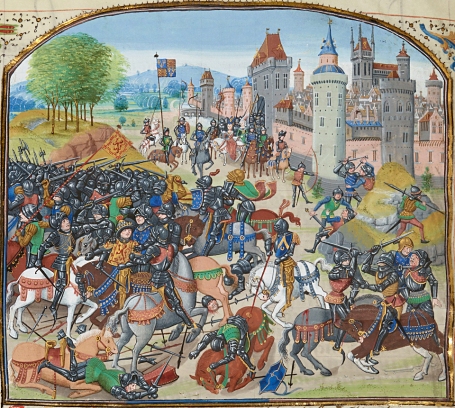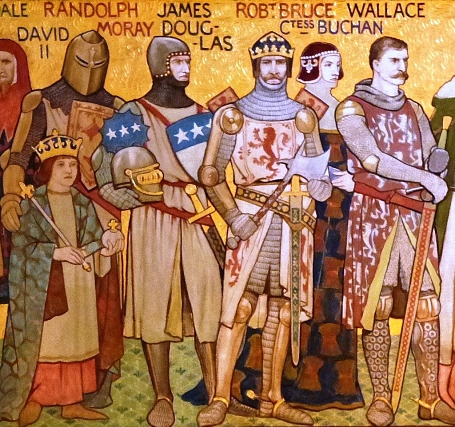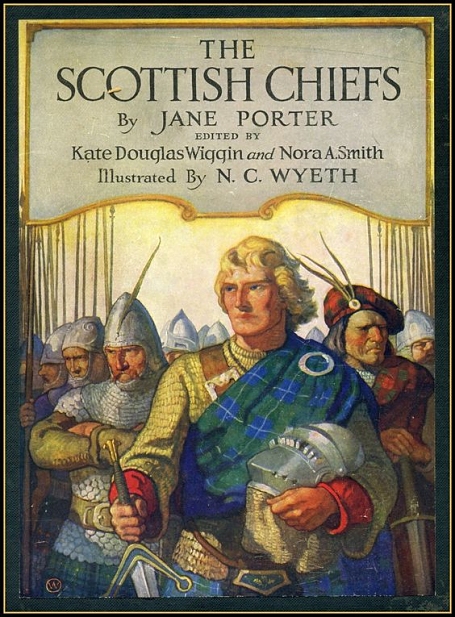The Life and Heroick Actions of the Renoun'd Sir William Wallace,
General and Governour of Scotland
by William Hamilton of Gilbertfield
Synopsis (Continued)
Lord Woodstock sets out to rescue the town of Dundee but finds Wallace waiting there with eight thousand stout fighting men. They meet on Sherrif Moor and seven thousand of Woodstock's ten thousand men fall in battle. The remainder, including Woodstock, are killed when they will not yield.
Wallace moves on to Stirling where carpenters dismantle the bridge. Along the coast they disable boats by removing boards.
Earl Malcolm and Sir John the Graham come to meet Wallace at Stirling, bringing news of King Edward close by at Torphichen. Stuart of Bute and Cummine (John Comyn) each rally ten thousand and march to Falkirk.
News comes to the gathering that Edward's force has pitched camp at Slamannan Moor, south of Falkirk. Jop reports that they are one hundred thousand strong.
The Comyn hatches a plot, telling the Lord Stuart that Wallace should not preceed Stuart in the vanguard. Stuart asks Wallace about his plans as Edward's force was so great. Wallace tells him he has won battles facing much worse odds and they should fight. Stuart says he will lead the Scots into battle and this enrages Wallace who recognizes the hand of Comyn in the ploy. He speaks out, saying he saved Comyn from great danger, only to be thanked by treachery. With an oath, Wallace withdraws himself and his ten thousand men.
The English rally to this news and The Stuart soon recognizes Comyn's advice as false and only for his own ends, but it's too late. Earl Hartford advances with thirty thousand men against Stuart. The battle is fierce and twenty thousand English fall but ten thousand more join in support. Now The Bruce and Bishop Beik advance with forty thousand against Stuart. Wallace debates rejoining the battle, but decides he had been scorned and duped by Stuart and Comyn and watches as the English win the day.
Wallace's options are few and he chooses to retreat to Torwood, fighting through men led by The Bruce and Bishop Bek, killing eight thousand. Wallace remains with three hundred men, John the Graham and Lauder to harry their enemies flanks.
In combat against The Bruce, Wallace is wounded but fights on to rescue John the Graham and Lauder from danger. Graham falls to a mortal spear wound and, seeing it happen, Wallace flies into a rage, cutting down all who come before him. Bruce orders spearmen to pierce Wallace's horse and bring him down, but he escapes crossing the Carron Water at high tide. The wounded horse carries him across and falls dead on the shore.
Towards Torwood they march, with Bruce on the other side of the water. He calls across, asking Wallace why he will not cease from bloody wars and live in peace. Wallace replies, saying he only wants to defend his native land against the rule of Edward and has no desire to be king. The Bruce counsels him, offering him his life and freedom if only he will recognize Edward's rule. Wallace scornfully declines, calling The Bruce a traitor to his native land.
The Bruce offers to meet him on the morrow to take each others' counsel, and they agree to meet at three. Riding on to meet Edward and his lords at Linlithgow, The Bruce quickly sits down to eat and is mocked for not washing off the blood of battle. This puts him in a sour mood and he thinks again on what Wallace had said.
At Torwood Wallace rests and gathers his remaining ten thousand followers. In the morning they return to the battle scene and find Sir John the Graham's body, lament over him and arrange a burial at Falkirk.
The Bruce and Wallace meet and what starts as confrontation soon becomes appeasement. Bruce says he will fight against the Scots no more, but see out the term under his oath to Edward, and then come and join Wallace.
Wallace returns to Torwood and divides his men - some under Crawford and Lord Malcolm sent to Inneravin. He leads the others by the South Manwel to avoid being seen by English lookouts. They attack Edward's force who were greatly surprised.
Tents and pavilions are torn down as Wallace's men press on. Edward calls on The Bruce to rally with his twenty thousand men, but the Scots fight furiously and many of the English flee in disarray. Edward's banner is brought down and twenty thousand English are left dead in the town and fields. The Scots pursue the fleeing Southrons and many more are killed on Crawford Moor.
Edward calls upon The Bruce to charge the Scots, but instead of doing so, he asks to be freed from his oath of allegiance. From then on Edward watches The Bruce closely, knowing that his heart is with Scotland. They ride on to the English border at the Solway and accounted that, in all, fifty thousand men had been lost.
Wallace returns to St. Johnstoun via Edinburgh where he installs Crawford as captain, to meet the assembled Scottish Lords. With great pride he tells them of his victory and that once more, he's set the ancient Kingdom free. He wants no praise or reward and proposes to return to France where he is better regarded. With eighteen loyal supporters, all men of honor, he sets sail from Dundee.
Sailing south and close by the mouth of the river Humber, Wallace and his men spy a ship approaching – a pirate ship, the merchants say – and they cringe in fear and dread. Wallace tells them he fears no pirates and takes control of the ship, sending them all below deck. His eighteen men cover the deck and rigging and wait as the pirate, John of Lynn, with his seventy men, approach.
Blair, with three arrows kills three pirates but they return with shot, firing until it's spent. The Scots make great havoc made among the pirates, killing many and setting their sails on fire so they can't flee. In the end, all are dead, including John of Lynn. With plunder from the ship, Wallace and the merchants sail on to Flanders.
They travel to Paris and are welcomed by the King of France, and to Parliament, where Wallace is made a Knight and given gold. The King commands all his army to act upon any order Wallace should give. This greatly pleases Wallace who, with his loyal men, sets off to Guyen (Aquitaine) to fight against the English there.
Back in Scotland, Vallange the Knight, meets with John Monteith, Sir John Lennox and Sir Aymer and offers lands and fees if they will go to London and meet with Edward. Monteith tells Edward that the Scots want The Bruce for King. Within forty days Edward raises an army and, facing no resistance, marches to Scotland and takes over without the stroke of a sword. Many dissenting noblemen, including Sir William Douglas, Earl Thomas-Lord of Murray, Lord Frazer and Hugh the Hay are sent to English prisons.
Loyal Scots, Seaton, Lauder and Lundie take to the Bass, Earl Malcolm and The Campbell seek refuge in Bute, Ramsay and Ruthven flee north. Adam Wallace, Craigy and Boyd sail to Arran at night.
In Dunbar, Corspatrick pays fealty to Edward, as does Lord Abernathy, Soulis, Cummine (Comyn,) John of Lorn and The Lord of Brechin.
From Bute a plea is sent to Wallace, begging his return to relieve the nation and take the crown from Edward. He declines an immediate answer.
King Edward grants lands from Tay to Dee to the control of Lord York. Lord Bewmont commands the north, Lord Clifford the Southern Marches and Comyn, all of Galloway. The Merse and Berwick town are granted to the command of Soulis. Oliphant gives up Stirling Castle to Edward, demonstrating his support, but a long spell in an English prison was his reward.
Comyn deviously approaches The Bruce, praising him and saying he should be the King. The Bruce agrees, but says the time isn't right and he will not break his oath, though he is sorely hurt that his lands are divided amongst Englishmen and Scottish traitors. Comyn persists, saying he would gladly give up his lordships if The Bruce would resign his title to the Crown. He and his relatives, who now hold sway over large territories, would throw in with The Bruce to oust Edward.
The Bruce suggests it would be well if Wallace could be brought back to fight. Comyn, who has his own eyes on the Crown, is against this but they agree that night and sign papers sealing their plans. Bruce returns to Edward's court and stays there more than three years before claiming his right to the Crown.
The ballad, The Life and Heroick Actions of the Renoun'd Sir William Wallace, General and Governour of Scotland, by William Hamilton of Gilbertfield, 1722, is in the public domain.

The Kingdom of England and the Kingdom of Scotland fought dozens of battles with each other. They fought typically over land, particularly Berwick-Upon-Tweed, and the Anglo-Scottish border frequently changed as a result. Read more at Wikipedia.

The First War of Scottish Independence was the initial chapter of engagements in a series of warring periods between English and Scottish forces lasting from the invasion by England in 1296 ... Read more at Wikipedia.

Digitized version of The Scottish Chiefs, by Jane Porter, a novelization published in 1921 by Charles Scribner's Sons, about William Wallace and the First Scottish War of Independence. Read online at archive.org.